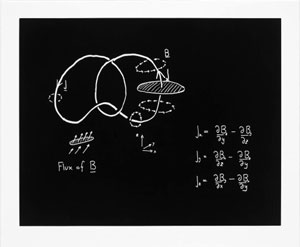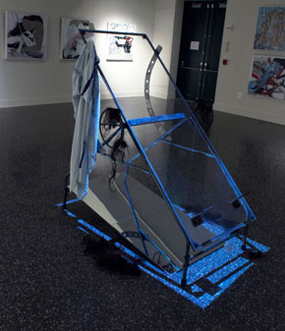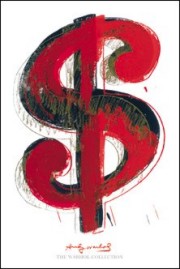Twisting Art and Math
John Haberin New York City
Concinnitas and Twisted Data
Sarah Meyohas and the Art of Money
A noted architect and theorist of early Renaissance Italy described beauty as concinnitas, a "skillful joining." Could he have had in mind the intersection of science, mathematics, and art?
Probably not, but he did provide an account of linear perspective that a mathematician would envy. And now an exhibition adopts his term for art or science as not a record of things seen, but rather the equations that make things possible. Meantime, if your own associations with math are more formidable and clinical, that, too may say something about art and science. In a digital age, both may be collecting images and information on you that you would hesitate to share.  "Twisted Data" finds its own beauty in a process that has been around longer than you may care to think. For Sarah Meyohas, the data and the beauty can derive even from Wall Street.
"Twisted Data" finds its own beauty in a process that has been around longer than you may care to think. For Sarah Meyohas, the data and the beauty can derive even from Wall Street.
A skillful joining
Concinnitas began as a chance conversation between strangers, a publisher and a mathematician. Robert Feldman of Parasol Press and Daniel Rockmore of Dartmouth discovered a shared interest in art and knowledge of Minimalism. Their project grew to include ten of the greatest living mathematicians and physicists. Each selected an equation close to his heart and central to his work, and each rendered it in his own hand in what became a print. Writing in Renaissance Florence, Leon Battista Alberti did indeed plead for art as a skillful joining. How fitting, then, that the series is a collaboration many times over.
If the collaboration seems to lack for an artist, pay no mind. Depending on one's philosophy of mathematics, its true artist and architect might be logic or nature itself. Each contributor also submitted a text on the chosen formula's meaning and beauty, which could well boil down to the same thing. Simon Donaldson accompanies Ampère's law of electricity and magnetism with a picture, because "they stimulate different ways of thought," the pictorial and the symbolic—but again as "different descriptions of the same thing." Another contributor, Freeman Dyson, would surely have shared the Nobel Prize with Richard Feynman and others, but the prize can go to no more than three in a given year. Such is the power of mathematics.
Rockmore and Feldman made their choices, too, in search of significance and beauty. When the first approached the subject of art and science, he imagined pictures of objects in nature—perhaps not unlike pencil drawings of leaves and undergrowth by Bill Richards, in the gallery's front room. Their intricacy and precision approach all-over abstraction. In the back room, Richard Purdy derives his pleasantly out-of-control grids from an algorithm, like Sol LeWitt as a professor of computer science. Feldman, though, had in mind the math alone as artistic enough. The resulting aquatints look like chalk on a blackboard.
Be grateful that they, like indeed most artists, still prefer chalk to whiteboards and PowerPoint. Be grateful, too, that the contributors speak personally, from experience. Steven Weinberg, who won the Nobel Prize for uniting electricity and magnetism with the weak force that governs radioactivity, still marvels at his own discovery. "Just change a minus sign to a plus sign and the whole thing would be incoherent." Most choose to illustrate their own work, although a few, like Donaldson, look back to its inspiration. The law governing an ordinary electromagnet led him to the "topology of four-dimensional spaces." Stephen Smale looks all the way back to Sir Isaac Newton's method for approximating the solution to otherwise insoluble equations.
Some texts accompanying the prints are difficult, but then so often is art. Murray Gell-Mann, who won the Nobel Prize for his theory of nature's elementary particles, named their constituents quarks, after a line in James Joyce. Had, I once got to ask, he actually read Finnegans Wake? As much as anyone, he replied. Weinberg put his discovery in the form of another difficult quantity, a Lagrangian. To work with it, a physicist would minimize it—further testimony to the economy of art and nature.
All offer a take on beauty and its seductions. As Gell-Mann puts it, the work just felt good. Yet that, too, can be misleading—in his case, leading him to omit a term in a more complete theory. Symmetry "kept us from venturing into territory . . . not yet fully explored." For David Mumford, the math "still feels . . . like a strange joke the creator is playing on us." One might say the same about many a work of art.
Old fears and new twists
Perhaps the most unnerving thing about Haunted Files is how easily it is haunted. That abandoned desk shoved so casually against the wall belongs, a subtitle insists, to the Eugenics Record Office.  The clutter of office supplies and papers, spilling onto the floor, may hold information on me or you. Yet it seems ill designed for ready access to much of anything, much less high-tech secrets of the soul. And that for Noah Fuller and John Kuo Wei Tchen is half the point. People are haunted so easily, because fears may arise from almost nothing, but also because the threat may yet be real.
The clutter of office supplies and papers, spilling onto the floor, may hold information on me or you. Yet it seems ill designed for ready access to much of anything, much less high-tech secrets of the soul. And that for Noah Fuller and John Kuo Wei Tchen is half the point. People are haunted so easily, because fears may arise from almost nothing, but also because the threat may yet be real.
In a show called "Twisted Data," one has every right to expect a new twist on design and nature, but there, too, do not overlook what was there all along. If Haunted Files seems way too low tech for today, when it takes so little to map or to hack the human genome, an actual Eugenics Record Office opened more than a century ago at Cold Spring Harbor on Long Island, where James D. Watson (a discoverer of the structure of DNA) later served as director, as fodder for laws to bar immigrants and to sterilize "inferior races" or the disabled. Fuller and Tchen claim to serve only as curators of its archives, much like Walid Raad in picturing death in the Middle East. Others rely on seriously dated and dangerous theories, like phrenology for Jeffrey Allen Price and Barbara Rosenthal or Nazi propaganda for Todd Herman. Still others rely on older media, such as archival prints, calligraphy, and even an Erector set. A gallery dedicated largely to artist books makes use of their delicacy and interiority as well.
The gallery devotes this room to group shows, often focused on art and science, design and science, or natural histories. (In the interest of full disclosure, I have a stake in it, although I offer no advice on what goes into it.) And science and art have much in common, starting with their twin commitments to beauty and experience, but including their authority in Western culture as well. Still, that can sound a little too optimistic, especially if one does not look closely enough at the sources of authority. Science has its dark and twisted side, too, in the flawed hands of humankind, while art practically depends on having it. If you prefer cheerful new twists on old dogs, you had better stick to Jeff Koons.
The word twisted also evokes the double helix, the secondary coiling of human chromosomes, and the mystery of what it means to be human. As for Fuller and Tchen, it raises questions about the denial of humanity to others, too. Rosary Solimanto's construction of steel, glass, a surgical gown, and human hair calls itself Rise of the Cyborg. On video, she squeezes herself into something between a fetus and a human guinea pig. Melissa Stern's Undesirables vary between headless clay and cut-off heads, but with glass "raccoon eyes." The Erector set serves Sarah Stengle, along with bullets and bones, as a Reliquary for a Dead Dove.
Often as not, as in politics today, a denial of humanity latches onto the "otherness" of race. Haunted Files exhibited one year ago at New York University's Asian/Pacific/American Institute. A silken accordion book for Geraldine Ondrizek comes in Shades of White. Yet race to a scientist is a fiction, and so to the rest of us is art. Patricia Olynyk borrows from medical imaging, but for what is first and foremost an image. Rosenthal and Herman adopt video and x-ray technology for a haunting beauty in frightening experiments. Charlie Friedman appropriates images from Joan Miró for an entire gross anatomy.
Art has at least one advantage over science: it is palpable, even when one cannot touch. Price fashions his phrenology experiments from used sponges, as Dirty Mind. Art also has the advantage of a long view. Bradstifter pairs pages from old medical texts with their mirror images upside-down, while Bram Harris turns to calligraphy for his Japanese Genetic Code. One could write off ghosts like racism as safely past, but check in with me again after Donald Trump becomes president.
Playing the market
Here money is everything, but money is no object. You may know it as the art world. At least it may seem that way crossing 24th Street, to such bywords of value as Gagosian and Mary Boone. But is there an art to making money? Sarah Meyohas, for one, is playing the market. For her (as she told Artspace), "the market itself is a medium"—and "just as malleable."
That boast might not make sense to artists struggling even to find a market, but then this is the north side of the street, at 303. It might not make sense either to those of us obliged to pinch pennies. Yet there is a solution to that, too, in penny stocks. For three weeks, Meyohas is trading them, right from the gallery, and turning her trades into art. She is charting the movement of stocks on canvas, as fleeting fortunes and more lasting images. And who knows who will be paying the price? 
Performance art, too, is fleeting. The day after her opening, it had almost vanished entirely. She sat at the center of the gallery, at a desk barely large enough to accommodate her. An unsuspecting visitor could walk warily past, up to one of twelve identical white canvases, hoping against hope that small differences would come into view. Meyohas was filling the time by knitting, since Wall Street is closed Saturdays, and answering questions for those who dared. Think of an approachable version of Marina Abramovic and The Artist Is Present at MoMA, without the ego trip or the wait.
Meyohas refuses to answer one question, about how much money it takes, but then art has its secrets. She does explain, though, that she seeks stocks small enough that her trades can alter their value. In a small back room, one could see results from day one. A canvas there holds the outlines of three slightly tilted towers, progressively diminishing in height like a tipsy bar graph. Oil stick connects them in a single black trace, almost like Japanese calligraphy. The movements belong to a company named Golden Enterprises.
The artist is aware that money isn't everything. She has issued her own version of Bitcoins, of value to pretty much no one, and she says that she is interested in companies not for themselves, but for the image. Yet she is also quite comfortable with money, with or without art. She is putting her own on the line, thanks no doubt to a family in the financial industry and a degree from Wharton, on top of a degree in photography from Yale. She is also marketing the canvases and twenty "unique" artist books. The latter incorporate gold nanoparticles, invisible to the eye but altering the surface with their reflected light.
This is neither a critique of the art world, like Michael Sailstorfer's buried gold for others to hunt, nor a pandering to privilege, like Damien Hirst and Jeff Koons. It has the innocence of a dollar sign by Andy Warhol, but with the potential to generate more of itself. At the closing performance, Meyohas had filled all but two of her canvases, sparingly as ever. She will not say how much she stood to gain or lose, and only the white wine was free. In the end her art is just another luxury good, for those to whom money changes everything, at times even itself. But then, maybe that is the point.

"Concinnitas" ran at Nancy Hoffman through January 23, 2016, "Twisted Data" at Central Booking through January 24, and Sarah Meyohas at 303 through January 30.




